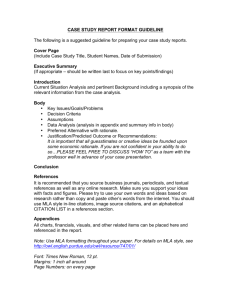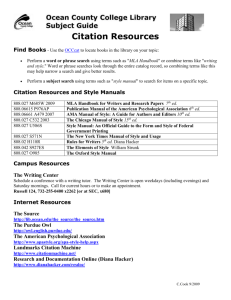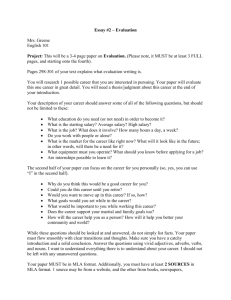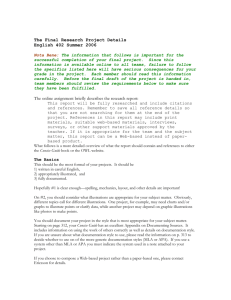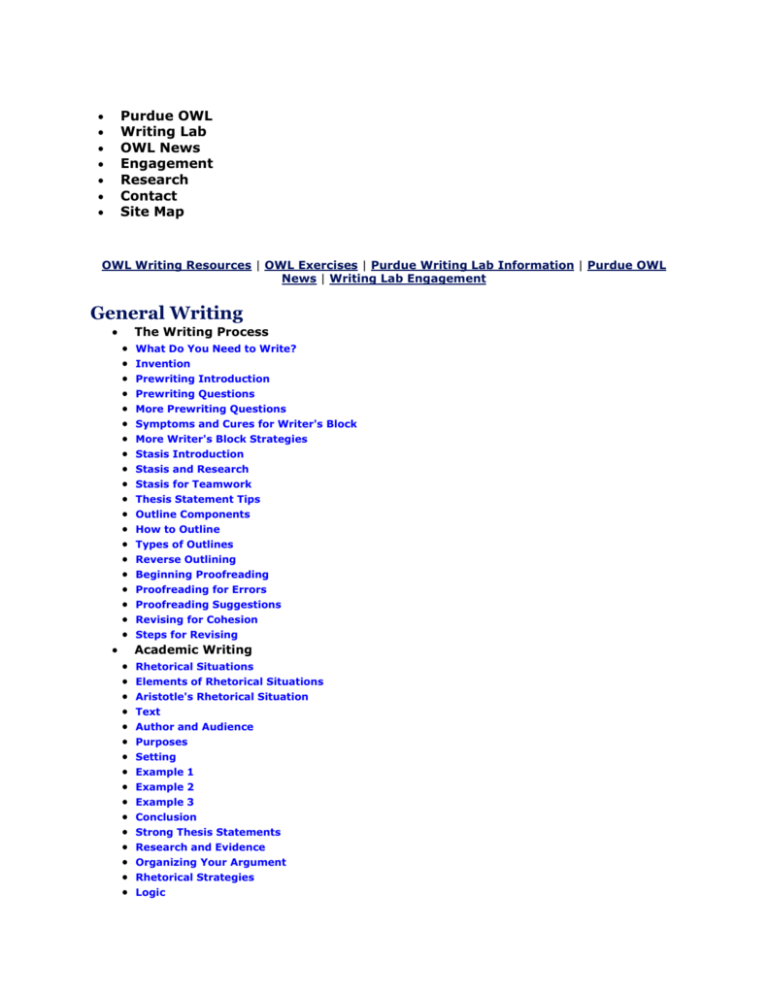
Purdue OWL
Writing Lab
OWL News
Engagement
Research
Contact
Site Map
OWL Writing Resources | OWL Exercises | Purdue Writing Lab Information | Purdue OWL
News | Writing Lab Engagement
General Writing
The Writing Process
What Do You Need to Write?
Invention
Prewriting Introduction
Prewriting Questions
More Prewriting Questions
Symptoms and Cures for Writer's Block
More Writer's Block Strategies
Stasis Introduction
Stasis and Research
Stasis for Teamwork
Thesis Statement Tips
Outline Components
How to Outline
Types of Outlines
Reverse Outlining
Beginning Proofreading
Proofreading for Errors
Proofreading Suggestions
Revising for Cohesion
Steps for Revising
Academic Writing
Rhetorical Situations
Elements of Rhetorical Situations
Aristotle's Rhetorical Situation
Text
Author and Audience
Purposes
Setting
Example 1
Example 2
Example 3
Conclusion
Strong Thesis Statements
Research and Evidence
Organizing Your Argument
Rhetorical Strategies
Logic
Using Logic
Fallacies
Logic in Writing
Does Logic Always Work?
Improprieties
On Paragraphs
Paragraphing
Essay Writing
Expository Essays
Descriptive Essays
Narrative Essays
Argumentative Essays
Conciseness
Eliminating Words
Changing Phrases
Avoid Common Pitfalls
Paramedic Method
Reverse Paramedic Method
Visual-Textual Devices
Punctuation Marks
Choice and Arrangement
Sentence and Clause Arrangement
Variation
Sentence Types
For Short, Choppy Sentences
For Repeated Subjects or Topics
Similar Sentence Patterns or Rhythms
Appropriate Language: Overview
Levels of Formality
Group Jargon
Deceitful Language and Euphemisms
Stereotypes and Biased Language
Appropriate Pronoun Usage
Active and Passive Voice
Active Versus Passive Voice
More about Passive Voice
Choosing Passive Voice
Changing Passive to Active Voice
More Suggestions
Verbs: Voice and Mood
Email Etiquette
Email Etiquette for Students
Common Writing Assignments
Understanding Writing Assignments
Argument Papers
Body Paragraphs
Rebuttal Sections
Conclusions
Writing a Research Paper
Genre and the Research Paper
Choosing a Topic
Identifying Audiences
Where do I Begin?
Exploratory Papers
Organizing an Exploratory Essay
Annotated Bibliographies
Annotated Bibliography Example
Annotated Bibliography Samples
Book Reports
Definitions
Essays for Exams
Book Reviews
Academic Proposals
Conference Proposals
Presenting Conference Papers
Journal Abstracts
Submitting the Journal Abstract
Book Proposals
Academic Proposals
Submitting an Undergraduate Journal Article
Mechanics
HOCs and LOCs
Sentence Clarity
Parts of Speech Overview
Sentence Clarity Presentation
Sentence Fragments
Transitions
Transitional Devices
Correcting Dangling Modifiers
Parallel Structure
Two-Part (Phrasal) Verbs (Idioms)
Separable Phrasal Verbs
Inseparable Phrasal Verbs
Intransitive Phrasal Verbs
Help with Capitals
Gerunds
Participles
Infinitives
Gerunds, Participles, and Infinitives
Grammar
Common Words that Sound Alike
Writing Numbers
Adjectives and Adverbs
Avoiding Common Errors
Adjectives with Count and Noncount Nouns
Adjective or Adverb?
Appositives
A versus An
Using Articles
Time, Place, and Introducing Objects
To, On (to), In (to)
Prepositions of Location: At, In, On
Spatial Relationships
Using Pronouns Clearly
Pronoun Case
Introduction to Defining Clauses
Punctuation
Punctuation Overview
Punctuation in Sentences
Sentence Punctuation Patterns
Independent and Dependent Clauses
Run On Sentences
Comma Slide Presentation
Commas: Quick Rules
Extended Rules for Commas
Commas After Introductions
Commas vs. Semicolons
Commas with Nonessential Elements
Apostrophe Introduction
Hyphen Use
Using Quotation Marks
Extended Rules for Quotation Marks
More Quotation Mark Rules
Quotation Marks with Fiction
Quotation Mark Exercise and Answers
Visual Rhetoric
Relative Pronouns in Non-Defining Clauses
Defining vs. Non-Defining
Basic Rules
Plurals, Articles, and Quantity Words
Count, Noncount Nouns with Articles, Adjectives
Subject-Verb Agreement
Sequence of Tenses
Passive Verb Tenses
Active Verb Tenses
Verb Tense Consistency
Verbs with Helpers
Active Verb Tenses
Irregular Verbs
Commonly Confused Verbs
Visual Rhetoric: Overview
Visual Rhetoric: Text Elements
Visual Rhetoric: Color
Visual Rhetoric: Images
Analyzing Visual Documents
Elements of Analysis
Organizing Your Analysis
Fonts with Purpose
Font Features
Font Personality
Additional Font Tips
Color Theory Presentation
PowerPoint Quick Guide
Before You Start
Design Principles
Practical Guides
Undergraduate Applications
Advice from Undergraduate Admissions Officers
Graduate School Applications
Media File Index
Overview: Planning Timeline
Overview: Process and Materials
Overview: After you Apply to Graduate School
Researching Programs: An Introduction
Research Programs: Practical Considerations
Researching Programs: Profiling Your Research Interests
Researching Programs: Profiling Faculty
Statements of Purpose: Overview and Before You Draft
Statements of Purpose: Drafting Your Statement
Statements of Purpose: After You Finish a Draft
Graduate School Applications: Requesting Recommendation Letters
Workshops and PowerPoints
Sample Papers
Sample Employment Documents
Purdue OWL Vidcasts
Purdue OWL Podcasts
Contrast
Alignment
Repetition
OWL Mail General Writing FAQs
OWL Mail General Writing FAQs
Research and Citation
Conducting Research
Where do I begin?
Online vs. Print
Sources
Primary Research
What is Primary Research?
Research Ethics
Pitfalls of Primary Research
Interviewing
Surveying
Interview and Survey Questions
Observing
Analysis
Analyzing Primary Data
Overview
Evaluating Bibliographic Citations
Evaluation During Reading
Print vs. Internet
Overview
The Internet and Search Engines
Search Engines and Directories
Searching with a Search Engine
Searching with a Web Directory
Search Engines
Search the Invisible Web
Other Useful Sites
Other Search Strategies
Internet References
Dictionaries and Manuals
Online References
Indexes for Writers
Online Libraries
Online Books and E-texts
Online News Sources
Purdue Library Database Tutorials
Using Research
Introduction
Quick Tips
Descriptive Statistics
Writing with Descriptive Statistics
Basic Inferential Statistics
Writing with Inferential Statistics
Statistics and Visuals
Key Terms
Strategies for Fair Use
Quoting, Paraphrasing, and Summarizing
Paraphrasing
Paraphrasing: Sample Essay
Paraphrasing
Paraphrasing Exercise
Paraphrasing Exercise Answers
Overview
Documenting Electronic Sources
Online Guides
Overview
Is It Plagiarism?
Safe Practices
Plagiarism Exercise
Best Practices for Teachers
Scientific Abstracts Presentation
Manuscript Formatting
In-Text (Citation) References
References Page Formatting
Manuscript Writing Style
Overview
Complete Discipline Listing
Citation Style Chart
APA Style
APA Workshop
General Format
In-Text Citations: The Basics
In-Text Citations: Author/Authors
Footnotes and Endnotes
Reference List: Basic Rules
Reference List: Author/Authors
Reference List: Articles in Periodicals
Reference List: Books
Reference List: Other Print Sources
Reference List: Electronic Sources
Reference List: Other Non-Print Sources
Additional Resources
Types of APA Papers
APA Stylistics: Avoiding Bias
APA Stylistics: Basics
APA Headings and Seriation
APA PowerPoint Slide Presentation
APA Sample Paper
APA Tables and Figures 1
APA Tables and Figures 2
APA Abbreviations
Statistics in APA
APA Classroom Poster
APA Changes 6th Edition
OWL Mail APA FAQs
MLA Style
MLA Overview and Workshop
MLA Formatting and Style Guide
MLA In-Text Citations: The Basics
MLA Formatting Quotations
MLA Endnotes and Footnotes
MLA Works Cited Page: Basic Format
MLA Works Cited Page: Books
MLA Works Cited: Periodicals
MLA Works Cited: Electronic Sources
MLA Works Cited: Other Common Sources
MLA Additional Resources
MLA Abbreviations
MLA Sample Works Cited Page
MLA Sample Paper
MLA Tables, Figures, and Examples
MLA PowerPoint Presentation
MLA Undergraduate Sample Paper
MLA Classroom Poster
OWL Mail MLA FAQs
Chicago Manual 16th Edition
Chicago Manual of Style 16th Edition
General Format
Books
Periodicals
Web Sources
Film and Television
Interviews, Personal Communication
Lectures and Presentations
Public and Unpublished Materials
CMS Author Date Sample Paper
CMS NB Sample Paper
CMS NB PowerPoint Presentation
CMS Author Date PowerPoint Presentation
CMS Author Date Classroom Poster
CMS NB Classroom Poster
Teacher and Tutor Resources
Writing Instructors
Parents
Grades 7-12 Instructors and Students
Non-Purdue Users
Purdue Instructors and Students
Writing Tutors
Adult Basic Education
Introduction
WAC Programs
Further Reading
Writing in Nursing Bibliography
Science Writing Bibliography Essay
Creative Nonfiction
The Personal Memoir
Literary Journalism
Lyric Essays
Assignments
Poetry in Writing Courses
Mid to Advanced Level Courses
Sample Assignment
Additional Resources
Detailed Writing and Procedural Transitions
Summary and Description
Deliverables and Evaluation
Activities
Resources for Instructors
Sample Deliverables
Email Etiquette for Professors
Lab Quick Tour
Meeting One-on-One with Students
Tutoring a Résumé
Tutoring Cover Letters
Tutoring Beginning Poets
Tutoring Creative Writers
Pitfalls for Fiction Writers
Helpful Resources
Metaphors in Creative Writing
Tutoring Grammar
Rationales for Tutoring Grammar
Strategies for Tutoring Grammar
Teaching Resources
Conducting an Interview Presentation
Job Acceptance Letter Presentation
Invention Presentation
Preventing Plagiarism
Contextualizing Plagiarism
Plagiarism Attitude Scale
Handout: Plagiarism Attitude Scale
Truth or Consequences
Handout: Truth or Consequences
The Big Picture
Authorship and Popular Plagiarism
Copyright and Plagiarism
Handout: Copyright and Plagiarism
Collaborative Authorship
Handout: Collaborative Authorship
Defining Our Terms
Class Plagiarism Policy
Comparing Policies
Handout: Comparing Policies
Avoiding Plagiarism
Summarizing, Paraphrasing, and Quoting
Peer Summarizing
Anonymous Paraphrasing
Paraphrasing from Media
Handout: Paraphrasing from Media
Using In-text Citations
Handout: Using In-text Citations
Quoting Others
Handout: Quoting Others
Summary, Paraphrase, and Quotation in Context
Handout: Summary, Paraphrase, and Quotation in Context
Subject Specific Writing
Professional, Technical Writing
Workplace Writers
Rhetorical Awareness
Applying User-Centered Design
Glossary and References
Participatory Design
Overview
Development Stage
Reading and Action Stage
Higher Order Concerns
Later Order Concerns
Parallel Structure
Tone
HATS
Accentuating the Positives
The Basic Business Letter
Sample Letters
Audience and Purpose
Parts of a Memo
Format
Sample Memo
Four Point Action Closing
Writing Report Abstracts
Reports, Proposals, and Technical Papers
Purpose and Audience
Organization and Other Tips
Revision
Revising for Clarity
Tailoring Language
Organization and Correctness
Writing in Literature
Terms
Introduction to Literary Theory
Moral Criticism, Dramatic Construction
Formalism
Psychoanalytic Criticism
Marxist Criticism
Reader-Response Criticism (1960s-present)
Structuralism and Semiotics
Postmodern Criticism
New Historicism, Cultural Studies
Post-Colonial Criticism
Feminist Criticism
Gender Studies and Queer Theory
Close Reading
Developing a Thesis
Pre-Writing
Introduction
Literature Topics and Research
Formatting
Overview
The Prompt Paper
General Research Papers
Conducting Research
Reading Criticism
Building an Argument
Reading a Novel or Story
Reading a Poem
Reading a Play
Writing About Poetry
Image in Poetry
Images and Their Uses
Exercises
Poetry: Close Reading
Writing in the Social Sciences
Social Work Literature Review Guidelines
Writing in Psychology Overview
Rhetorical Considerations and Style
Experimental Reports 1
Experimental Reports 2
Tables, Appendices, Footnotes and Endnotes
Sources for More Information
APA Sample Paper: Experimental Psychology
Writing in Engineering
Engineering Reports
Introduction
Purposes and Types
Reports and Memos
Report Checklist
Report Sections
The Report Body
Abstracts and Executive Summaries
Mechanical Elements
Design Notebook
Project Charter
Travel Writing
Introduction
Readability Presentation
Readability Handout
Paramedic Method Presentation
Paramedic Method Handout
Creative Writing
Fiction Writing Basics
Fiction Writing Basics 2
Fiction Writing Basics 3
Pattern and Variation
Pattern
Variation
Sound and Meter
Meter and Scansion
Poetic Feet, Line Length
Sound and Rhyme
Other Matters of Sound
Visual Patterning
Visual Variation, Exercises
Medical Writing
Introduction
Original Scholarly Article
Revised Article
Reporting on Conference Presentations
Journalism and Journalistic Writing
Adjectives Presentation
Adjectives Handout
Intra-Paragraph Organization Presentation
Intra-Paragraph Organization Handout
Verb Use Presentation
Verb Use Handout
Macro Level Cohesion Presentation
Macro Level Cohesion Handout
Micro Level Cohesion Presentation
Micro Level Cohesion Handout
Concise Language Presentation
Eliminating Unnecessary Words Handout
Parallelism Handout
Document Design Presentation
Poster Design Handout
Group Work Presentation
Group Work Handout
Writing Proposals Handout
Annotated Sample Documents
Mechanical Engineering Writing Enhancement Program
Memo Writing
90-Second Semicolon Vidcasts
Report Writing
Introduction
AP Style
Media Ethics
The Inverted Pyramid
Writing Leads
Writing in Nursing
Three General Rules
Writing in the Field
List of Nursing Resources
Writing as a Veterinary Technician
Writing as a Veterinary Technician
Patient Signalment, Client Information
History, Presenting Chief Complaint
Current Health Status, History
Past, Birth, and Referral History
Patient Assessment
Technician Evaluation
Interventions
Rationale for Interventions
Continued Patient Reassessment
Desired Resolutions
Progress Notes
Discharge Planning
Legal Issues of Documentation
Sample Care Plan Example
Writing in the Purdue SURF Program
SURF Workshop Resources Introduction
SURF Workshop Resources: Problem Statements
Problem Statements PowerPoint Presentation
Problem Statements Handout Instructions
Problem Statements Handout 1: Situating Your Work
Problem Statements Handout 2: Reading a Project Poster
Job Search Writing
Preparing an Application
Tailoring Documents
Determining Audience
Addressing Audience
Tips and Terms
The Personal Statement
Examples
Advice from Admissions Officers
Top 10 Rules and Pitfalls
Job Skills Checklist
Action Verbs
Action Verb List
Sample Documents
Job Search Letters
Employment Letters
Request For a Reference
Follow-Up Letter
Inquiry Letters
Follow-Up After No Response
Acceptance Letter
Rejection Letter
Requesting Further Negotiations
Letter When You are Rejected
Thank You Letters
Model Reference Request
Model for Negotiations
Model for Reply to Rejection
Model for Inquiry Letter
Model for Rejecting a Job Offer
Model for Acceptance Letter
Model for Reference Request Letter
Model for Interview Follow-Up
What Is a Cover Letter?
Quick Content Tips
Quick Formatting Tips
Showing Off Knowledge of Company
Before Sending the Letter
Researching Job Positions
Reading Job Ads
Researching Companies
Communicating with Insiders
Using University Career Centers
Addressing Qualifications
Cover Letter Headings
Addressing Cover Letters
Cover Letter Introductions
Cover Letter Body Paragraphs
Cover Letter Closings
Introduction
What to Include
Formatting and Organization
Academic Cover Letters
Academic Cover Letter Sample
Résumés and Vitas
Introduction
Contact Information Section
Education Section
Work Experience Section
Using Two Pages or More
Introduction
General Guidelines
Résumé Design
PowerPoint Presentation
Management Résumés
Résumé Workshop
Education Section
Experience Section
Honors and Activities Section
Skills Section
PowerPoint Presentation
Reference Sheets
Writing the CV
Sample Résumés
Skills Résumé Sample
Chronological Résumé Sample
Functional Résumé Sample
Interactive Résumé
English as a Second Language
ESL Instructors, Tutors
ESL Orientation Presentation
ESL Teacher Resources
ESL Instructors and Students
ESL Students
A Cultural Introduction
Tips for Writing in North American Colleges
Tips for Writing in North American Colleges: Directness
Tips for Writing in North American Colleges: Objectivity
Tips for Writing in North American Colleges: Reasonability
Tips for Writing in North American Colleges: Conciseness
Tips for Writing in North American Colleges: Revision
Plagiarism and ESL Writers
Writing for Global Business Audiences: An Introduction
Writing for an Indian Audience
Writing for a Chinese Audience
Samples
Writing for a North American Audience
About the OWL
OWL Information
OWL Fact Sheet
Frequently Asked Questions
How to Use the OWL
Navigating the New OWL
Terms and Conditions of Fair Use
OWL Art 1
OWL Art 2
OWL Art 3
Current OWL Exercises
OWL Exercises
Grammar Exercises
Adjective or Adverb Exercise 1
Adjective or Adverb Exercise 2
Appositive Exercise
A or An? Exercise
Articles Exercise 1
Articles Exercise 2
Count and Noncount Nouns Exercise
Count and Noncount Nouns Exercise
Count and Noncount Nouns Exercise
Count and Noncount Nouns Exercise
Count and Noncount Nouns Exercise
Quantity Terms Exercise
Prepositions of Direction Exercise
Tense Consistency Exercise 1
Tense Consistency Exercise 2
Tense Consistency Exercise 3
Tense Consistency Exercise 4
Punctuation Exercises
Punctuation Exercise
Apostrophes Exercise
Quotation Marks Exercise
Comma Exercise 1
Comma Exercise 2
Comma Exercise 3
Comma Exercise 4
Comma Exercise 5
1
2
3
4
5
After Introductions Exercise 1
After Introductions Exercise 2
After Introductions Exercise 3
Commas vs. Semicolons - Compound Sentences
Nonessential Elements Exercise 1
Nonessential Elements Exercise 2
Nonessential Elements Exercise 3
Spelling Exercises
-ible and -able Spelling Exercise 1
-ible and -able Spelling Exercise 2
Accept/Except Spelling Exercise
Affect/Effect Spelling Exercise
EI/IE Spelling Rules Exercise 1
EI/IE Spelling Rules Exercise 2
EI/IE Spelling Rules Exercise 3
EI/IE Spelling Rules Exercise 4
Sentence Structure
Identifying Independent and Dependent Clauses Exer
Sentence Fragments Exercise 1
Sentence Fragments Exercise 2
Sentence Fragments Exercise 3
Run-ons, Comma Splices, and Fused Sentences
Subject and Verb Agreement Exercise
Sentence Style
Eliminating Wordiness Exercise 1
Eliminating Wordiness Exercise 2
Eliminating Wordiness Exercise 3
Paraphrasing
Paraphrasing Exercise
Writing Numbers
Writing Numbers Exercise
Purdue Writing Lab Information
About
Giving to the Purdue Writing Lab
A Welcome from the Directors
About Our Writing Lab Coordinators
Awards and Featured Articles
Fact Sheet
Redesigning the Writing Lab and OWL Pages
Where are the OWL handouts?
Mission, Goals, and Description
Alumni
Alumni Annotations
Facilities
Computing Resources
Lab Reference Library
Satellite Locations
Study & Work Area
Giving to the Writing Lab
Jobs in the Writing Lab
General Tutoring Job Information
Opportunities for Purdue Graduate Students in English 2013
Opportunities for Purdue Undergraduate Students 2013
Policies
Student FAQs
Faculty and Instructor FAQs
OWL Mail Policies FAQs
Services
Business Writing Consultants (BWCs)
ESL Conversation Groups
The Grammar Gang Blog
Instructor Consultation
One-on-one Tutorials
Undergraduate Teaching Assistants
Email a Tutor
Writing Workshops
In-lab ESL Software
Overview of Services
Writing Lab Workshops
Writing Lab Engagement Resources
Engagement
CWEST
GED Preparation
GED Practice
Essay Organization Questions
Sentence Structure Questions
Usage Questions
Mechanics Questions
GED Essay Game
Part 1. Lessons 1-4
1.1: Topic Sentences
1.1: Relevance of Ideas
1.1: Order of Ideas
1.1: Transitions
1.2: Fragments and Run-Ons
1.2: Comma Splices
1.2: Parallel Structure
1.2: Modifiers
1.2: Coordination and Subordination
1.2: Verb Tense
1.3: Subject-Verb Agreement
1.3: Pronouns
1.4: Capitalization
1.4: Commas
1.4: Semi-Colons, Colons, and Quotation Marks
1.4: Italics and Underlining
1.4: Spelling
1.4: Contractions
1.4: Homonyms
Suggested Resources
Part 2. Lessons 1-5
2.1: Understanding the Prompt
2.1: Brainstorm for the Essay
2.1: Developing a Main Idea
2.2: Parts of the Essay, Outlining
2.2: Developing a Thesis
2.2: Topic Sentences
2.3: Introductions
2.3: Body Paragraphs
2.3: Conclusions
2.4: Spelling and Punctuation
2.4: Sentences and Sentence Structure
2.4: Subject-Verb Agreement and Tense
2.4: Capital Letters
2.4: Strategies for Writing Essays
2.5: Word Choice
Tips for Success
Suggested Resources
GED Essay Game
Exercise Answers
Exercise Answers for Part 1, Lesson 1
Exercise Answers for Part 1, Lesson 2
Exercise Answers for Part 1, Lesson 3
Exercise Answers for Part 1, Lesson 4
More Writing Exercises
ESL Resources
Combining Sentences
Conjunctions and Coordination
Subordination, Exercises
Discourse Connectors
Topic Sentences, Exercises
Prepositions
Prepositions of Time, Place, and Introducing Objects
Prepositions of Direction - To
Prepositions of Direction - Onto
Prepositions of Direction - Into
Prepositions of Spatial Relationship - A
Prepositions of Spatial Relationship - B
Prepositions of Spatial Relationship - F-O
Prepositions of Spatial Relationship - T-W
Preposition Exercise
Pronouns
Pronouns - Clarity
Pronouns - Issues of Gender
Pronoun Exercise
Punctuation
Punctuation - Commas
Punctuation - Quotation Marks and Apostrophes
Punctuation - Semicolons, Colons, and Parentheses
Punctuation - Hyphens and Dashes
Punctuation Exercise
Paraphrasing and Summary
Paraphrasing
Summarizing
Paraphrasing and Summarizing Exercise
Exercise Answers
Answers for Sentence Exercises
Answers Preposition Exercises
Answers for Pronoun Exercises
Answers for Punctuation Exercises
Answers for Paraphrasing and Summarizing Exercises
Job Search Resources
Reading & Using Job Ads
Reading & Using Job Ads Part 1
Reading & Using Job Ads Part 2
Understanding Job Ads Part 1
Understanding Job Ads Part 2
Job Applications
Job Application Overview
Application Worksheet Part 1
Application Worksheet Part 2
Application Worksheet Part 3
Application Worksheet Part 4
Résumés
Résumé Overview Part 1
Résumé Overview Part 2
Résumé Sections Part 1
Résumé Sections Part 2
Résumé Sections Part 3
Résumé Design Part 1
Résumé Design Part 2
Checking Your Résumé
Cover Letters
Cover Letter Overview
Cover Letters Part 1
Cover Letters Part 2
Cover Letters Part 3
Cover Letters Part 4
Cover Letters Part 5
Cover Letters Part 6
Interviews
Interviews Part 1
Interviews Part 2
Follow-Up, Thank You Letters
Follow-Up & Thank You Letter Overview
Follow-Up & Thank You Letters Part 1
Follow-Up & Thank You Letters Part 2
Follow-Up & Thank You Letters Part 3
Follow-Up & Thank You Letters Part 4
Sample Résumés & Letters
Working Class Résumés & Letters
Résumé & Cover Letter Presentations
How to Use the CWEST
Copyright ©1995-2013 by The Writing Lab & The OWL at Purdue and Purdue University. All rights
reserved. This material may not be published, reproduced, broadcast, rewritten, or redistributed
without permission. Use of this site constitutes acceptance of our terms and conditions of fair use.


